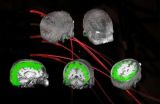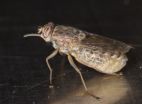(Press-News.org) PHILADELPHIA – A new study suggests that targeting B cells, which are a type of white blood cell in the immune system, may be associated with reduced disease activity for people with multiple sclerosis (MS). The study is released today and will be presented at the American Academy of Neurology's 66th Annual Meeting in Philadelphia, April 26 to May 3, 2014.
For the study, 231 people with relapsing-remitting MS received either a placebo or one of several low dosages of the drug ofatumumab, which is an anti-B cell antibody, for 24 weeks, with the first 12 weeks making up the placebo-controlled period. The main objective was to determine the effects of ofatumumab dosing regimens compared to placebo on the total number of new brain lesions assessed every four weeks over a 12-week period.
All dose groups including placebo showed lesion activity in the first four weeks with lesion suppression in all ofatumumab dose groups from weeks four to12. Researchers measured the amount of B cells in participants and compared that to the total number of new brain lesions that appeared on brain scans, which is a marker of disease activity.
The researchers found that when B cells were reduced to below a threshold of 64 cells per microliter, disease activity, as measured by appearance of new brain lesions, was significantly reduced. On average, participants had an annualized rate of less than one new brain lesion per year when B cells were maintained below a threshold of 32 to 64 cells per microliter, compared with 16 lesions without treatment.
The most common side effects, defined as those occurring in at least five percent of participants and at a rate twice that of placebo for weeks zero to12, were injection-related reaction, dizziness, anxiety, fever, respiratory tract infection and nerve pain.
Study author Daren Austin, PhD, of GlaxoSmithKline in Uxbridge, United Kingdom, and a member of the American Academy of Neurology, said the study results also suggest that peripheral, rather than central, B cells may be the most relevant target for anti-B cell therapy.
"These results need to be validated, of course, but the findings are interesting," Austin said. "They provide new insight into the mechanism of B cells in MS and present a possible new target threshold for exploring the potential benefit of anti-B cell therapy."
Ofatumumab is not approved anywhere in the world for use in the treatment of multiple scelorosis.
INFORMATION:
The study was supported by GlaxoSmithKline.
Learn more about MS at http://www.aan.com/patients.
The American Academy of Neurology, an association of more than 27,000 neurologists and neuroscience professionals, is dedicated to promoting the highest quality patient-centered neurologic care. A neurologist is a doctor with specialized training in diagnosing, treating and managing disorders of the brain and nervous system such as Alzheimer's disease, stroke, migraine, multiple sclerosis, brain injury, Parkinson's disease and epilepsy.
For more information about the American Academy of Neurology, visit http://www.aan.com or find us on Facebook, Twitter, Google+ and YouTube.
Editor's Note:
Dr. Austin will present his findings at 6:15 p.m. ET, on Wednesday, April 30, 2014, in Grand Ballroom A of the Pennsylvania Convention Center in Philadelphia.
Dr. Austin is available for advance interviews as well. Please contact Rachel Seroka, rseroka@aan.com, to schedule an advance interview.
To access Non-Emerging Science abstracts to be presented at the 2014 AAN Annual Meeting, visit https://www.aan.com/conferences/2014-annual-meeting/browse-abstracts. Emerging Science abstracts are embargoed until 12:01a.m., ET, Friday, April 25, 2014, unless otherwise noted by the Academy's Media and Public Relations Department.
Media Contacts:
Rachel Seroka, rseroka@aan.com, (612) 928-6129
Michelle Uher, muher@aan.com, (612) 928-6120
Study suggests targeting B cells may help with MS
2014-04-24
ELSE PRESS RELEASES FROM THIS DATE:
New guidelines aim to improve care for babies with heart problems in the womb
2014-04-24
Fetal heart experts working with the American Heart Association have developed guidelines to help healthcare providers care for unborn babies with heart problems, as well as their families.
The statement, Diagnosis and Treatment of Fetal Cardiac Disease, is published in the American Heart Association journal, Circulation.
"Congenital heart disease is the most common birth defect that can result in either death or significant health problems in newborn babies," said Mary T. Donofrio, M.D., lead writer of the statement, and director of the Fetal Heart Program and Critical ...
Genetic alterations in shared biological pathways as major risk factor for ASD
2014-04-24
A substantial proportion of risk for developing autism spectrum disorders (ASD), resides in genes that are part of specific, interconnected biological pathways, according to researchers from the Icahn School of Medicine at Mount Sinai, who conducted a broad study of almost 2,500 families in the United States and throughout the world. The study, titled "Convergence of Genes and Cellular Pathways Dysregulated in Autism Spectrum Disorders," was first published online in the American Journal of Human Genetics on April 24.
ASD affects about one percent of the population ...
Controlling brain waves to improve vision
2014-04-24
Have you ever accidently missed a red light or a stop sign? Or have you heard someone mention a visible event that you passed by but totally missed seeing?
"When we have different things competing for our attention, we can only be aware of so much of what we see," said Kyle Mathewson, Beckman Institute Postdoctoral Fellow at the University of Illinois. "For example, when you're driving, you might really be concentrating on obeying traffic signals."
But say there's an unexpected event: an emergency vehicle, a pedestrian, or an animal running into the road—will you actually ...
Computer program could help solve arson cases
2014-04-24
Sifting through the chemical clues left behind by arson is delicate, time-consuming work, but University of Alberta researchers teaming with RCMP scientists in Canada, have found a way to speed the process.
A computer program developed by University of Alberta chemistry professor James Harynuk, his team of graduate and undergraduate researchers and the Royal Canadian Mounted Police National Forensic Laboratory Services, can cut the need for extra levels of human analysis, reducing the waiting time to find out the cause of a deliberately set fire.
That means quicker ...
'Horsing around' reduces stress hormones in youth
2014-04-24
PULLMAN, Wash. – New research from Washington State University reveals how youth who work with horses experience a substantial reduction in stress – and the evidence lies in kids' saliva.
The results are published in the American Psychological Association's Human-Animal Interaction Bulletin this month.
Pendry-80"We were coming at this from a prevention perspective," said Patricia Pendry, a developmental psychologist at WSU who studies how stress "gets under the skin" and the effects of prevention programs on human development. "We are especially interested in optimizing ...
JCI online ahead of print table of contents for April 24, 2014
2014-04-24
Ex vivo expansion of hematopoietic stem cells from cord blood
Compared to hematopoietic stem cells (HSCs) isolated from adults, HSCs isolated from cord blood (CB) have enhanced proliferative potential and can lead to hematological reconstitution when engrafted in children with hematological malignancies or genetic defects. Unfortunately, small numbers of HSCs are present in single CB collections, limiting their use as grafts for adults. For several decades investigators have used a variety of strategies to expand the numbers of CB HSC ex vivo with limited success. Evidence ...
Microscopic organism plays a big role in ocean carbon cycling, Scripps scientists discover
2014-04-24
It's broadly understood that the world's oceans play a crucial role in the global-scale cycling and exchange of carbon between Earth's ecosystems and atmosphere. Now scientists at Scripps Institution of Oceanography at UC San Diego have taken a leap forward in understanding the microscopic underpinnings of these processes.
When phytoplankton use carbon dioxide to make new cells, a substantial portion of that cellular material is released into the sea as a buffet of edible molecules collectively called "dissolved organic carbon." The majority of these molecules are eventually ...
What makes psychotic teens more at risk for suicide than other groups with psychosis?
2014-04-24
Suicide is a general risk for people with psychosis. According to the Journal of Psychiatry, 20 percent to 40 percent of those diagnosed with psychosis attempt suicide, and up to 10 percent succeed.
And teens with psychotic symptoms are nearly 70 times more likely to attempt suicide than adolescents in the general population, according to a 2013 study in JAMA Psychiatry.
But what contributes to such high numbers?
Jane Timmons-Mitchell, PhD, from Case Western Reserve University's social work school, and Tatiana Falcone, MD, from the Cleveland Clinic, reviewed studies ...
Solving the mystery of a superluminous supernova
2014-04-24
This release is available in Japanese.
An exceptionally bright supernova reported in 2013 is so luminous, a new study reports, because a lens in the sky amplified its light. The discovery of the lens settles an important controversy in the field of astronomy.
In 2010, a team of scientists observed a supernova, PS1-10afx, shining brighter than any other in its class.
"PS1-10afx is like nothing we have seen before," said senior author Robert Quimby of the University of Tokyo's Kavli Institute for the Physics and Mathematics of the Universe.
Its exceptional glow ...
A scourge of rural Africa, the tsetse fly is genetically deciphered
2014-04-24
New Haven, Conn. – An international team of researchers led by the Yale School of Public Health has successfully sequenced the genetic code of the tsetse fly, opening the door to scientific breakthroughs that could reduce or end the scourge of African sleeping sickness in sub-Saharan Africa. The study is published in the journal Science.
It took nearly 10 years and more than 140 scientists from numerous countries to map the genome of the fly, also known as Glossina morsitans. Tsetse flies are the sole insect vectors of a disease that threatens the health of millions ...

